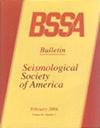The 2023 New Zealand Ground-Motion Database
IF 2.9
3区 地球科学
Q2 GEOCHEMISTRY & GEOPHYSICS
引用次数: 2
Abstract
This article summarizes the development of the 2023 New Zealand ground-motion database (NZGMDB). A preceding version was formally used as the central ground-motion database in the ground-motion characterization modeling for the 2022 New Zealand (NZ) National Seismic Hazard Model (NSHM) revision. The database contains ground motions for events with a moment magnitude greater than ∼3.0 from the years 2000 to the end of 2022. Several challenges associated with NZ earthquake source metadata are explained, including determination of earthquake location, magnitude, tectonic classification, and finite-fault geometry, among others. The site table leverages the site database developed as a part of the 2022 NZ NSHM revision, and several definitions of source-to-site distance are computed for the propagation path table. The ground-motion quality classification was initially assessed using a neural network. Subsequent waveform quality verification was conducted and additional quality criteria were enforced to ensure a sufficiently high-quality database. Standard processing techniques were applied to the ground motions before intensity measure (IM) calculation. IMs in the database include peak ground acceleration, 5%-damped pseudoacceleration response spectra, smoothed Fourier amplitude spectra, and other cumulative and duration-related metrics. The NZGMDB is publicly available and routinely updated as new and higher quality data become available.2023 年新西兰地动数据库
本文概述了 2023 年新西兰地动数据库(NZGMDB)的开发过程。在 2022 年新西兰(NZ)国家地震危险性模型(NSHM)修订版的地动特征建模中,前一版本被正式用作中央地动数据库。该数据库包含 2000 年至 2022 年底矩震级大于 3.0 的地动事件。解释了与新西兰震源元数据相关的几个挑战,包括确定地震位置、震级、构造分类和有限断层几何等。场地表利用了作为 2022 年新西兰国家人类安全和健康标准修订工作一部分而开发的场地数据库,并为传播路径表计算了震源到场地距离的若干定义。地动质量分类最初使用神经网络进行评估。随后进行了波形质量验证,并执行了额外的质量标准,以确保数据库质量足够高。在计算地震动强度(IM)之前,对地震动采用了标准处理技术。数据库中的强度指标包括地面加速度峰值、5% 阻尼假加速度响应谱、平滑傅里叶振幅谱以及其他累积和持续时间相关指标。NZGMDB 向公众开放,并随着新数据和高质量数据的出现而定期更新。
本文章由计算机程序翻译,如有差异,请以英文原文为准。
求助全文
约1分钟内获得全文
求助全文
来源期刊

Bulletin of the Seismological Society of America
地学-地球化学与地球物理
CiteScore
5.80
自引率
13.30%
发文量
140
审稿时长
3 months
期刊介绍:
The Bulletin of the Seismological Society of America, commonly referred to as BSSA, (ISSN 0037-1106) is the premier journal of advanced research in earthquake seismology and related disciplines. It first appeared in 1911 and became a bimonthly in 1963. Each issue is composed of scientific papers on the various aspects of seismology, including investigation of specific earthquakes, theoretical and observational studies of seismic waves, inverse methods for determining the structure of the Earth or the dynamics of the earthquake source, seismometry, earthquake hazard and risk estimation, seismotectonics, and earthquake engineering. Special issues focus on important earthquakes or rapidly changing topics in seismology. BSSA is published by the Seismological Society of America.
 求助内容:
求助内容: 应助结果提醒方式:
应助结果提醒方式:


